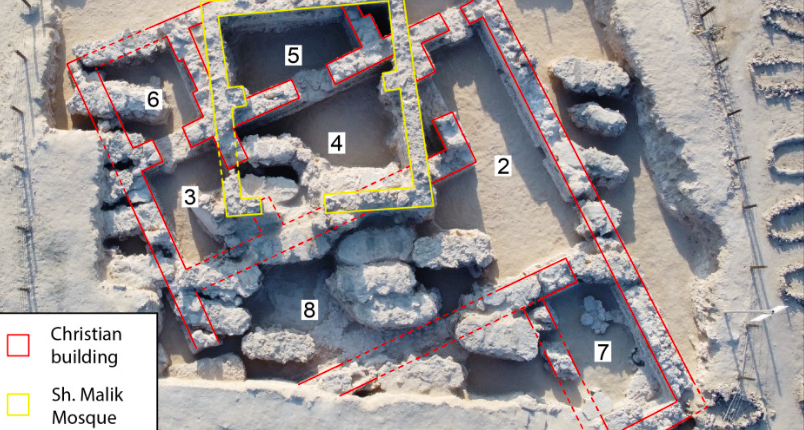The building was left intact as a mosque was later built over it. (Photo: University of Exeter)
Newly discovered ancient structures shed light on the historical roots of Christian communities in the Gulf region.
In a groundbreaking discovery, archaeologists in Bahrain have unearthed one of the Gulf region’s oldest Christian buildings, dating back to the 4th century, a significant find that provides the first physical evidence of the presence of an ancient Christian community in the island nation.
The Eastern Church, also known as the Nestorian Church, flourished in the region for several centuries until the spread of Islam in the 7th century.
Bahraini and British teams have excavated an eight-room building believed to have served as the residence of a diocesan bishop in the village of Samahij on the northern coast of Muharraq Island. The joint project, initiated by the Bahrain Authority for Culture and Antiquities, led by Dr Salman Al Mahari, and supervised by Professor Timothy Insall of the University of Exeter’s Institute of Arab and Islamic Studies, began in 2019, with careful excavation continuing until 2023.
Their research uncovers early Christian settlement in Bahrain, dating back centuries before the spread of Islam. Radiocarbon dating confirms that the Samahij site was inhabited from the mid-4th century AD to the mid-8th century AD, but was likely abandoned as Islam spread further among the local population.
Excavations began at a mound in the Samahij cemetery, where archaeologists discovered the remains of a 300-year-old mosque buried underground. Digging deeper revealed a large building with eight rooms, including a kitchen, dining room, workshop and three living quarters.
“The findings suggest that the building may have been the residence of the diocesan bishops, including Samahij,” the Bahrain government media team said in a statement.
“Records show the region’s links with central church authorities: one bishop was deposed in 410 AD and another in the mid-7th century was accused of challenging the unity of the church,” the statement added.
The find is unique in that it is located in a modern, densely populated town, unlike previous Christian structures found in remote areas along the Gulf coast.
Important finds during the excavations included three plaster crosses (two of which were on the outside of the building, one that was probably kept as a personal keepsake) and a wall carving with a fish symbol and part of a “Chi Rho” etching, which represents the words of Christ.
Dr Al Mahli said excavations are nearly complete, stressing the site’s importance to Bahrain’s history and providing valuable insights into the Christian presence in the region.
Details about the building and the lives of its inhabitants were also discovered. Built with stone walls and plaster floors, the building had sockets and holes that indicated the location of doors and seats. The kitchen had a built-in oven with a base and storage space. Artefacts show that the inhabitants consumed meat, fish, shellfish and a variety of crops and enjoyed a good standard of living.
The finds of semi-precious agate beads and fragments of Indian pottery suggest trade, especially with India. A small cup and 12 copper coins suggest the use of Sassanid currency. Furthermore, a spindle wheel and copper needles suggest the possibility of cloth being made for religious purposes.
“We stress the importance of the site and the need to preserve it, highlighting its historical and archaeological value,” Professor Insol said.
“We were intrigued to discover that someone had used bitumen to paint part of a face on a mother-of-pearl shell, presumably that of a child who lived in the building,” the professor enthused. “This is the first physical evidence of a Nestorian church in Bahrain and gives us a fascinating insight into how people lived, worked and worshipped here.”
The discovery not only deepens our understanding of the region’s diverse religious history but also highlights the rich culture that existed in Bahrain long before the arrival of Islam.

